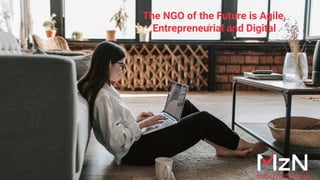
The Future NGO is Agile, digital and entrepreneurial.pptx.pdf
- 1. The NGO of the Future is Agile, Entrepreneurial and Digital
- 2. WHO Chris Meyer zu Natrup Managing Director WHAT We build better NGOs We help NGOs to be funded better
- 3. Talking points • Committed to deliver admits disruption • Agile is buzzword. Here‘s what it comes down to • Five lessons from agile transformations in 2020-21 • Action recommendations
- 4. • Nearly half of all UK NGOs may go bankrupt by 2023 (Bond survey Oct 2020, MzN analysis 2022). • Income to drop even further. 65% of UK NGOs expect income to fall in 2021-22. (Bond survey Oct 2020). • Nearly 80% of European NGOs expect a “lost period of 2020-21”, with static income. (MzN survey Summer 2020). • Staff redundancies, health related absences. • Disrupted operations during lockdowns. • Stress and frustration with workload, inept processes and outdated strategies. 1. Difficult times
- 5. ● Some NGOs do very well. Who and why? ● What do these have in common? ○ More used to change in recent years ○ Highly diversified income ○ More digital ○ Quicker in establishing new partnerships ○ Agile operating model 2. What it takes to deliver …..
- 6. This is about how we respond and scale. How we organise ourselves, how we work either opens up strategic opportunities, or closes them. It has to be based on our values and understanding of the people we serve and problems we address. 3. “Agility is not just a buzzword, it‘s how we work"
- 7. • Strategy sets targets, but does not prescribe ways to achieve them. • Data obsession: Measure, report, learn –> foresight. • Platform based: rapid new partnerships & project development capacity. • Trust based: Teams come together when and where needed, less formal structures, very flat hierarchy, open data. • Funding is increasingly diversified. 4. What is Agile?
- 8. Strategy Structure Systems We co-create Programmes with people at the centre e.g. Prog Development is platform based, drawing in partners as needed (R&D, implementation, advocacy) Platform is digital, open & secured and follows clear, pre-defined Prog.Dev Steps We fund our activities 75% from unrestricted and 25% restricted income e.g. Finance checks mix and has power to stop grant development or Our fundraising and social businesses are separately organised Finance automatically received real time data on financial performance of fundraising We will deliver programmes where they are needed, starting work within 90 days We deliver digitally first, delivering training, advocacy, behaviour change Digital learning, behaviour change and influencing systems
- 9. • Structures & Systems must actually support the Strategy, not just based on history • Trust requires data transparency: Objectives, Indicators and other data points should be freely available to inspire trust • Funding must be diversified: Government funding is not a viable path to impact • Data is the key to impact: collection -> analysis –> insight -> foresight • Make work work for people: Flexible work arrangements, platform based work allows people to work when they want/can 5. Lessons learned from agile transformations Diversified its funding in 2019, grew continuously in 2020 Puts data at its core in 2020, attracts substantial donor endorsements Fundamental restructure undergoing, to be ready for recurring migration waves
- 10. • Change can be instigated by shocks, trends & pressures (e.g. financial) • That type of change is often reactionary >> We are driven to change! >> This is often out of necessity but is not always the best way! • Driving Our Own Change – Prioritise what you can control! Accept the rest. • Change that is enacted by an organisation because it is desirable to do so. • Change that is designed to structure the organisation to support its strategy. • Change that is driven towards the future not driven by events of the past. 6. How to lead change! (not be driven by it)
- 11. Stay in touch! Deborah Mowesley deborah@mzninternational.com Chris Meyer zu Natrup chris@mzninternational.com Check out our blog and upcoming events on our website: www.mzninternational.com Ten tips to improve your proposal budget September 6th 2 to 3pm CET ‘Clearing the Air: 5 Tips on How to Proactively Manage Conflict in a Team’ by Carolin Gomulia Latest blog article: Upcoming webinars: Agile and Robustly Funded: NGOs and International Organizations Need New Ways to Survive and Thrive September 13th 2 to 3pm CET
